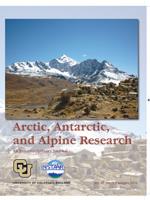Designed to accompany the touring exhibit of the same name from the Whatcom Museum, Vanishing Ice gathers a profusion of artistic works that address Earth's frozen places. Matilsky traces artists' representation of icy landscapes over two centuries, starting with pieces from 18th-century Western voyages of exploration and ending with new work, including a 2013 site-specific piece by Jyoti Duwadi made of melting ice blocks. Matilsky's stated goal is to “spotlight climate change in a new way,” and she largely succeeds.
The book traces the complicated relationship between science and art through two centuries. Eighteenth-century artists helped show a new concept: that of Earth changing naturally over geologic time. Today artists often reveal the “rapid transformation of nature occurring within a human lifespan,” driven by human action. (p. 14)
There are few canonical names in this book: the artists are generally less well-known, though part of international movements. A particular strength of the book is how it traces “connections between generations of artists over two centuries,” including how later artists often responded directly to previous works. Some artists go back to particular views captured in earlier works to show the changes there. Others are more loosely influenced by approach or philosophy. Rapidly sketching expedition artists, Romantic painters, early photographers, and contemporary artists working in a variety of media all make an appearance, and most are linked in some way to their predecessors. The book is organized by theme rather than chronology, which helps keep the dialog between generations of artists fluid.
Throughout, Matilsky delves into the artists' own lives, showing how their reactions to cold places emerged not only in their work, but in their causes, pursuits, or friendships. While these discussions are brief, they are full of fascinating tidbits. For example, Matilsky points out that when Jean Charles Rémond painted murals of four geologically significant landscapes for the Museum of Natural History in Paris, it was the first time that nature became the exclusive subject of decoration of a public space in the history of French patronage (p. 29).
Vanishing Ice is most notable for linking works by current artists to pieces from earlier traditions that inspired them. Ansel Adams' photograph Mount McKinley and Wonder Lake, Denali National Park and Preserve, Alaska is juxtaposed with Denali Denial by Chris Jordan, which copies the photograph's form in thousands of GMC Yukon Denali logos. Marc Theodore Bourrit's Mont Blanc's White Alley (1786) is compared with Patrizia Imhof's 2009 photograph from the same vantage point, showing the landscape without its mantle of glacial ice.
The connections can be less obvious as well. Frederic Edwin Church's The Icebergs is included (along with the story of its name change from The North). It is linked to Melted 4, by Cynthia Camlin, who was inspired by Church (p. 70). As a result, the book is a history of Western ideas of icy places: as hells; as magnificent, dangerous, or even ecstatic landscapes; or as fragile environments.
The choice of contemporary works is wide-ranging and excellent. Alexis Rockman's Adelies (2008) is an oil painting of penguins inhabiting a cube-shaped melting iceberg; one dives into the sea, but there is no apparent way for it to reach the top again. Anne Noble's Wilhelmina Bay, Antarctica (2005) depicts a cruise ship's promenade deck set up for lounging tourists with a view of Antarctic waters in the background. Xavier Cortada's Astrid (2007) is created using sediment and ice from Antarctica as drawing materials.
The book is centered firmly in the Western artistic tradition, and does not bring in many pieces from outside it. It also has a story to tell, and in the telling it neglects some things it could say. For instance, 18th-century artists are often characterized as “naturalist-explorers” who familiarized new audiences with the grandeur of alpine and polar landscapes and illustrated scientific content; but no real mention is made of the voyages' nationalistic aims. This framing is acknowledged in the text.
Supporting material includes an illustrated timeline, list of works in the exhibit, and bibliography. Those interested in the book may also enjoy the Whatcom Museum's exhibit web site, www.vanishing-ice.org.
This unusual and involving work is recommended for art, arctic history, and alpine history collections. It is highly recommended for the many readers interested in historic expeditions and/or climate change, who will appreciate the eye-opening dialog between art from many periods.





